30+ Lead Generation Statistics For 2024: The Definitive List
Lead generation, the act of identifying and cultivating new potential customers, continues to be a key focus for businesses and marketers right now – but it’s getting harder.
With so many businesses out there competing for sales leads, how do you stand out from the crowd?
To help you to rise to the challenge, we’ve put together 33 important lead generation statistics to inform your strategy.
These statistics show you the state of lead generation, how it’s changing, and highlight some new trends that you need to be aware of.
Editor’s picks
- 61% of marketers rank lead generation as their number one challenge. (HubSpot)
- 80% of marketers think marketing automation generates more leads (and conversions). (APSIS)
- 66% of marketers generate leads from social media after spending only six hours per week on social marketing. (Social Media Examiner)
General lead generation statistics
Here are the most important top-level lead generation statistics you need to know this year:
61% of marketers rank lead generation as their number one challenge
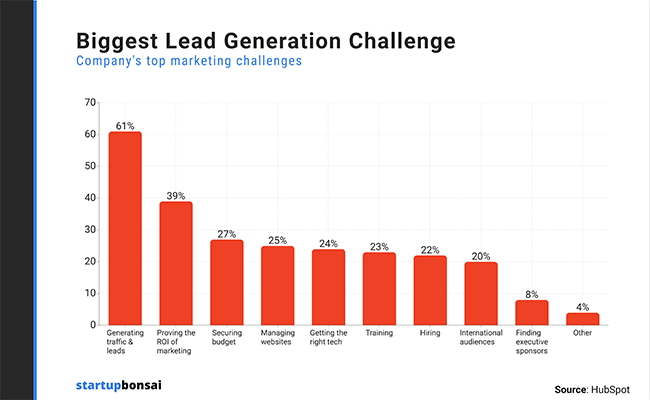
Lead generation isn’t as easy as it once was. According to a report from Hubspot, 61% of marketers consider generating traffic and leads to be their biggest challenge.
53% of marketers spend at least half of their budget on lead generation
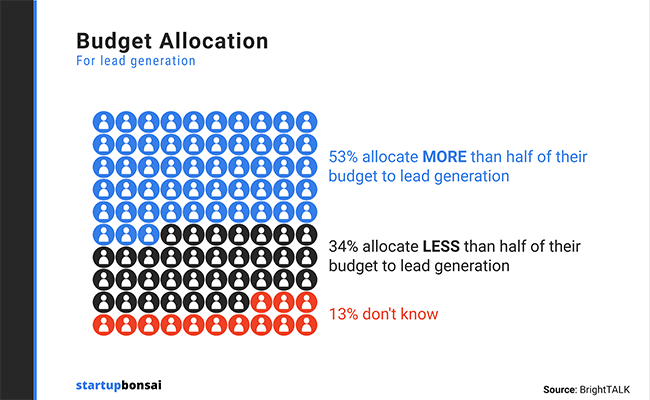
But while it may be more difficult, it’s no less important. Marketers are still focusing heavily on lead generation, with 53% of them spending half or more of their entire budget on lead gen efforts. Only 34% of marketers spend less than half their budget on lead generation. (Source: BrightTALK).
Less than one-fifth of marketers think outbound practices provide valuable leads
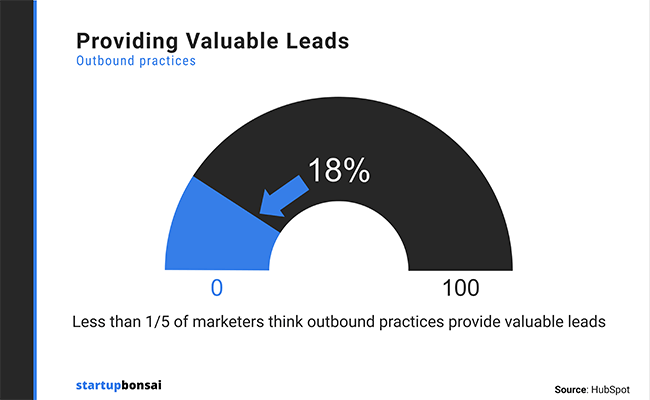
It looks like outbound lead generation is pretty much dead. Only 18% of marketers still think that outbound practices provide the highest-quality sales leads. Gone are the days of excessive cold-calling. Now, it’s all about inbound lead generation. (Source: Hubspot)
80% of marketers think marketing automation generates more leads (and conversions)
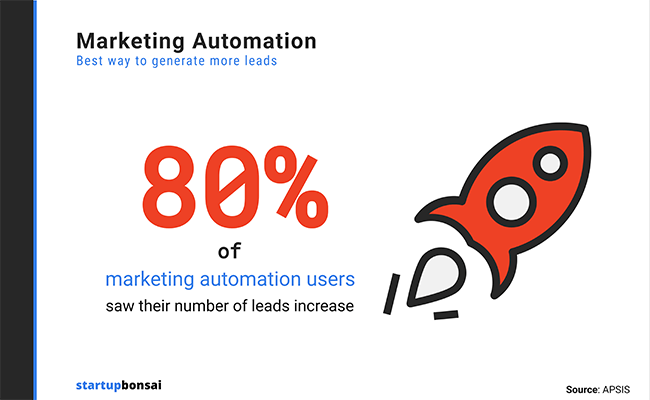
One of the biggest trends we’re seeing in lead generation is the increased use of automation software. According to recent reports, 80% of marketers that use automation software drive increased leads (as much as 451% more), and that 77% of them convert more leads than those that don’t use automation. (Source: APSIS)
Leads are 9x more likely to convert when businesses follow-up within 5 minutes
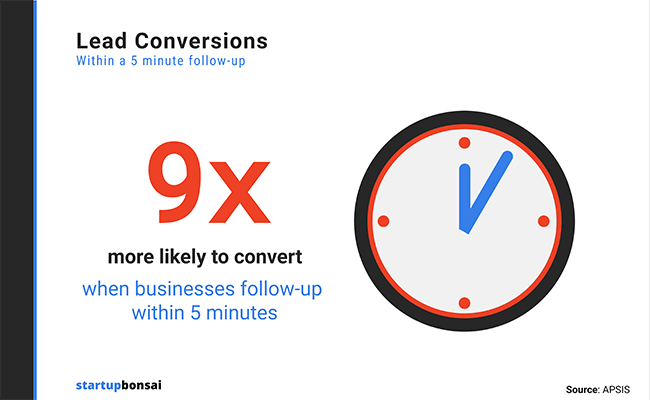
Another important trend to take note of is the increasing importance of rapid follow-ups. A 2019 study found that following up with online leads in less than 5 minutes makes them nine times more likely to convert into paying customers. (Source: Ziff Davis)
So how do you make sure your sales agents are responding within 5 minutes? Well, automation might be able to help. Modern AI-powered chatbots and CRMs are capable of automatically responding to your customers for you, offloading this task from your sales team and helping you to drive those conversions while spending less.
Outsourcing lead generation beats handling it in house
According to Fearless Competitor, outsourcing lead generation generates 43% better results than in-house lead generation. In light of those figures, it might be best to leave your lead generation to an agency and let your in-house team focus their efforts on other important marketing tasks.
The majority of midsize and large companies generate less than 5,000 qualified leads each month
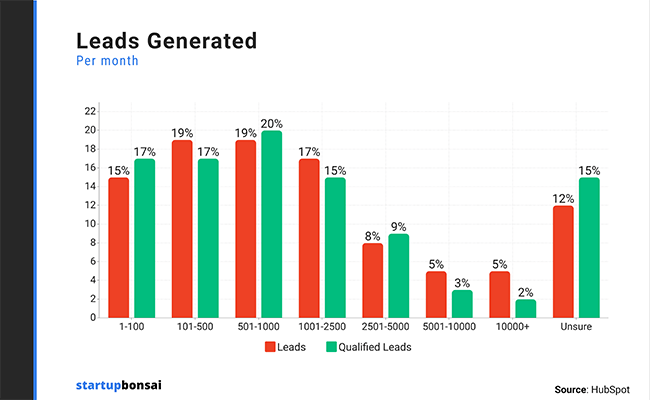
Interestingly, most larger companies seem to struggle to generate large numbers of qualified leads. A Hubspot report from 2017 suggests that the vast majority generate less than 5,000 per month, with the average being 1,877 leads per month. With numbers that small, it’s even more important to focus on converting as many of those leads as possible.
Social media for lead generation
What’s the most effective online channel for lead generation? It’s an important question. To try and get to the bottom of it, let’s compare some lead generation statistics across different marketing channels, starting with social.
66% of marketers generate leads from social media after spending only six hours per week on social marketing
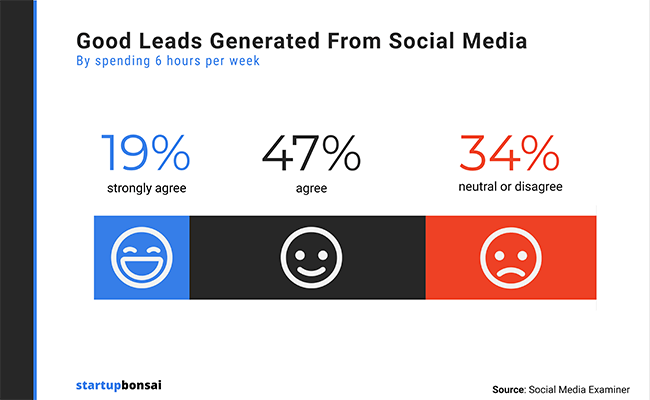
As long as you have a solid social strategy in place, you can see good lead generation results on social media with minimal time investment. Two-thirds of marketers that spend just six hours a week on social media but still manage to generate leads. (Source: Social Media Examiner)
Linkedin is the most effective social media channel for B2B lead generation
There are so many social platforms out there that it can be tough to know which one to focus on. In the B2B space, at least, the answer is clear: LinkedIn. LinkedIn dominates lead generation for B2B businesses, with 80% of B2B leads coming from the platform. (Source: Oktopost)
…It’s also massively underutilized
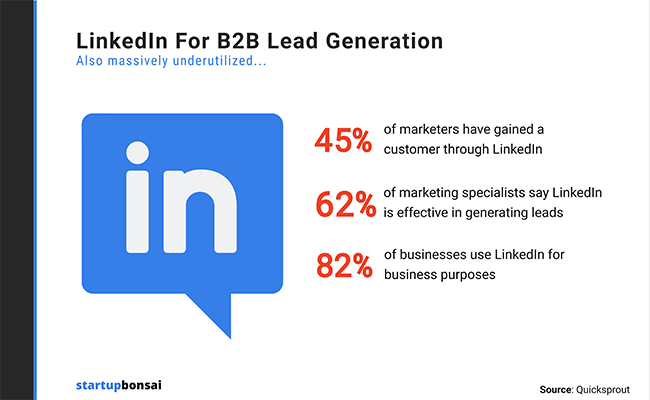
Despite being so effective for generating leads, LinkedIn looks relatively underutilized. Only 47% of marketers are actively using LinkedIn, despite the fact that 45% of them have gained customers through the platform. (Source: Quicksprout)
82% of social media leads come from Twitter
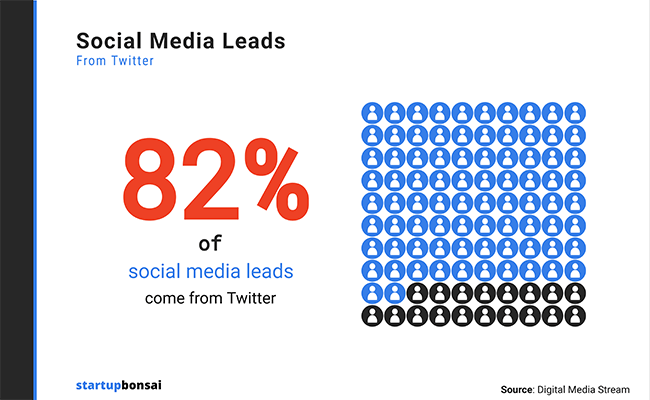
While LinkedIn might dominate in the B2B space, data from Quicksprout suggests Twitter may be the king of social media leads, finding that 82% of leads come from the platform. (Source: Digital Media Stream)
Content marketing for lead generation
Content marketing involves publishing valuable content to attract website traffic and leads. It’s one of the most important new inbound marketing channels. Here are some statistics that show how content marketing is used for lead generation.
Content marketing generates 3x as many leads as outbound marketing at less than half the cost

According to figures from Demand Metric, content marketing is thrice as effective at generating leads than outbound marketing while costing a whopping 62% less.
By focusing your lead generation efforts on creating and promoting great content instead of reaching out directly to potential customers, your budget will stretch further and you’ll see more leads.
Not only that, but you’ll also be improving your brand loyalty as you’re giving your customers something for free and making them feel more like a partner than a sales target.
80% of B2B companies use content marketing for lead gen
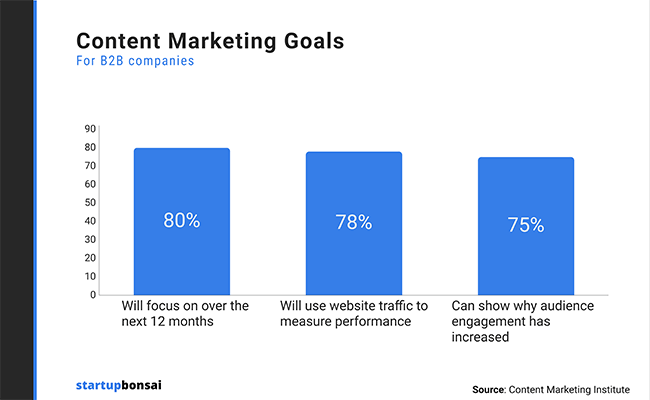
Considering the stats above, it’s no surprise that 80% of B2B marketers consider lead generation to be the top goal of their content marketing efforts. (Source: Content Marketing Institute)
Marketers with blogs are 13x as likely to drive positive ROIs
This is another statistic that shows how important content marketing is for generating leads. Marketers that use blogs to generate traffic are 13 times more likely to generate positive ROIs. If you haven’t got a company blog, it’s time to start one. (Source: Hubspot)
Effective blog headlines drive 500% more traffic
To get the most out of your content marketing efforts, make sure any blog posts you publish have attention-grabbing headlines. Effective headlines can boost clicks, and therefore page traffic, by as much as 500%. (Source: Wired)
Some studies show that numbers are an important component of effective headlines, so make sure you’re including them whenever suitable.
Note: If you’d like to learn more about content marketing, check out our post on content marketing statistics you need to know.
Email marketing for lead generation
Another important lead generation channel is email. Marketers continue to use email to both generate and nurture their sales leads. Here are a few email marketing statistics worth knowing about.
42% of companies consider email to be one of their most important lead generation channels
That’s right – 42%. If you thought that email was dead, you were wrong. Despite the hype around content marketing and social media, email continues to be one of the most effective lead generation channels. (Source: Strategic)
79% of B2B marketers think email is most effective for demand generation
Marketers surveyed in a 2018 study by the Content Marketing Institute credited email as their most effective channel for demand generation. (Source: Content Marketing Institute)
Email drives higher ROIs than any other lead generation tools
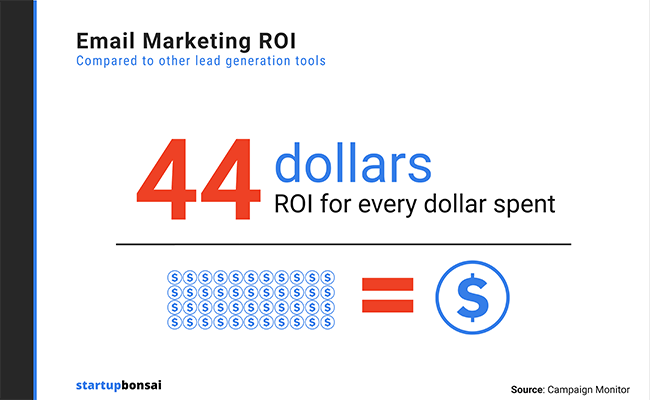
For every dollar you spend on email marketing, you can expect to earn a whopping $42 back. That’s an incredible 4400% ROI, higher than any other lead generation tool. (Source: Campaign Monitor)
Want to learn which tools you can use in your marketing strategy? Check out our article on lead generation software.
Emails sent at 1 PM get the best results
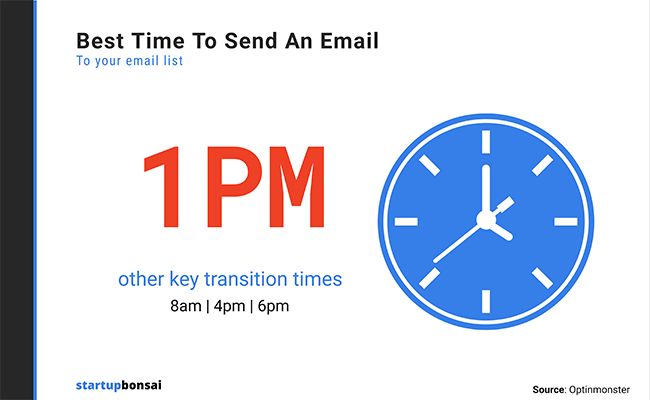
There have been plenty of studies looking into the best time to email leads, many of which have generated conflicting results. However, this one from Optinmonster convincingly highlighted 1 PM as the best time. Of course, everyone’s list is different, so make sure you A/B test to figure out your own golden hours.
B2B lead gen statistics
If you’re a B2B business, here are the most important lead generation statistics you should know about.
68% of B2B businesses use strategic landing pages for leads
Strategic landing pages continue to be critically important for conversion optimization. 68% of businesses use strategic, high-converting landing pages to get their leads to take action, whether that’s signing up to their mailing list, following them on social media, or making a purchase. (Source: Marketo)
Events may generate the most B2B leads
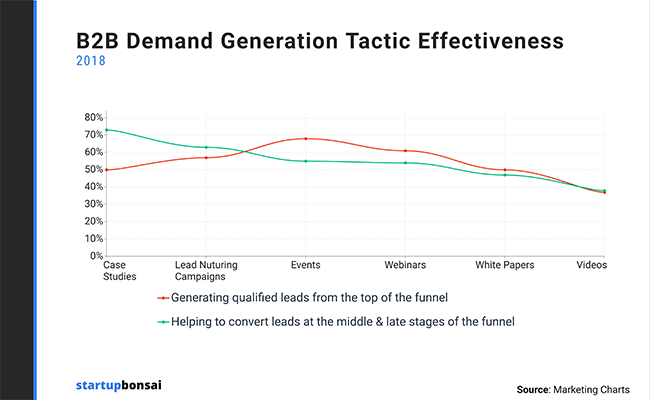
In the B2B space, offline lead generation may still be effective. A 2018 study from Marketing Charts found that events help B2B businesses to generate the most leads. It also found that case studies help B2B businesses to convert the most leads. (Source: Marketing Charts)
The average cost of a B2B sales lead ranges from $31 to $60
Marketing Insider Group measured the costs of B2B sales leads and found that average costs vary dramatically across different industries. Costs in the technology industry were at the low end of the spectrum, at just $31 per lead, whereas healthcare leads cost almost twice that at $60 per lead.
59% of B2B marketers think SEO has the biggest impact on lead gen
A 2012 study from Marketing Charts found that both B2B (59%) and B2C (49%) marketers thought SEO had the biggest impact on their lead generation goals. It’s been almost 8 years since that study took place, so whether or not SEO is still so relevant is up for debate. What do you think?
As a side note, if you want to learn more, check out our roundup of SEO statistics.
Lead nurturing statistics
Generating leads is only half the battle. If you want to turn those leads into sales, they need to be nurtured first. With that in mind, let’s look at some important lead nurturing statistics.
Nurtured leads produce 20% more sales opportunities
According to a DemandGen report, lead nurturing drives 20% more sales opportunities than non-nurtured leads. (Source: DemandGen)
Companies that nurture leads generate 50% more sales at 33% lower costs
Another study from Marketo found that businesses that nurture leads enjoy 50% more sales. They also found that those sales cost an average of 33% less than non-nurtured prospects. (Source: Marketo)
Nurtured leads spend 47% more than non-nurtured leads
Not only does lead nurturing lead to more sales, but it also helps to drive larger purchases. Annuitas found that nurtured prospects make 47% larger purchases than non-nurtured prospects. (Source: Annuitas)
Almost two-thirds of all leads aren’t sales-ready
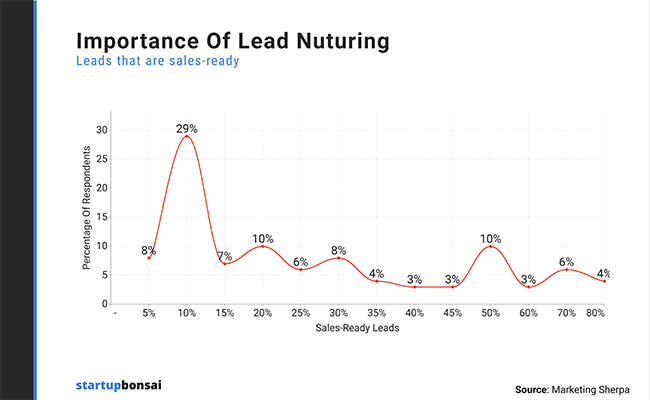
As if we needed more proof as to how important lead nurturing is, Marketing Sherpa found that a whopping 73% of leads aren’t sales-ready. To get them ready, marketing teams need to engage with them and move them down the sales funnel. (Source: Marketing Sherpa)
Emails for lead nurturing have higher CTRs
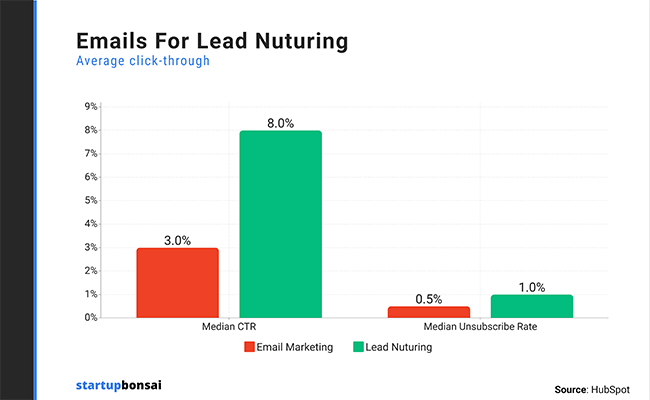
An interesting study from Hubspot found that emails sent out for lead nurturing purposes had an average click-through rate of 8%, significantly higher than regular emails, which had an average CTR of 3%. (Source: Hubspot)
…And 4-10x higher response rates
A DemandGen report found that lead nurturing emails also generate between 4 and 10 times as many responses than regular emails. (Source: DemandGen)
22% of B2B companies nurture leads weekly
How frequently should you be sending out lead nurturing emails? It’s an important question, and the answer is likely to be different for different businesses. However, a study from MarketingSherpa found that almost a quarter of businesses reach out to prospects each week, so that might be a good place to start! (Source: MarketingSherpa)
Lead conversion statistics
Before we wrap up, here are a final few lead conversion statistics worth knowing.
63% of leads who inquire about your business won’t convert for at least 3 months
Don’t expect those leads to convert to sales overnight, it’s best to approach conversions with a long-term mindset. In fact, Marketing Donut found that 63% of customers that ask for information about your brand won’t be ready to buy for at least three months. (Source: Marketing Donut)
70% of B2B marketers think video content helps convert leads
To generate more conversions, try using video. The Content Marketing Institute found that the majority of B2B marketers think video content is more effective at converting qualified leads than other types of content. (Source: Content Marketing Institute)
79% of your leads won’t ever convert to sales
This stat might seem a little disappointing, but it’s important to be realistic about your leads. The truth is, the vast majority of them won’t ever convert to sales, at least according to this study from Marketing Sherpa. (Source: Next Leap Strategy)
Final thoughts
Those are all the lead generation statistics we have for you!
Hopefully, they’ve given you some new insight to apply to your marketing strategy. The next step is to put some of these , be sure to check out our article on lead generation software.
Looking for more marketing statistics? You’ll find plenty of insights in these articles:
